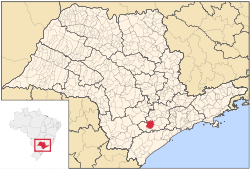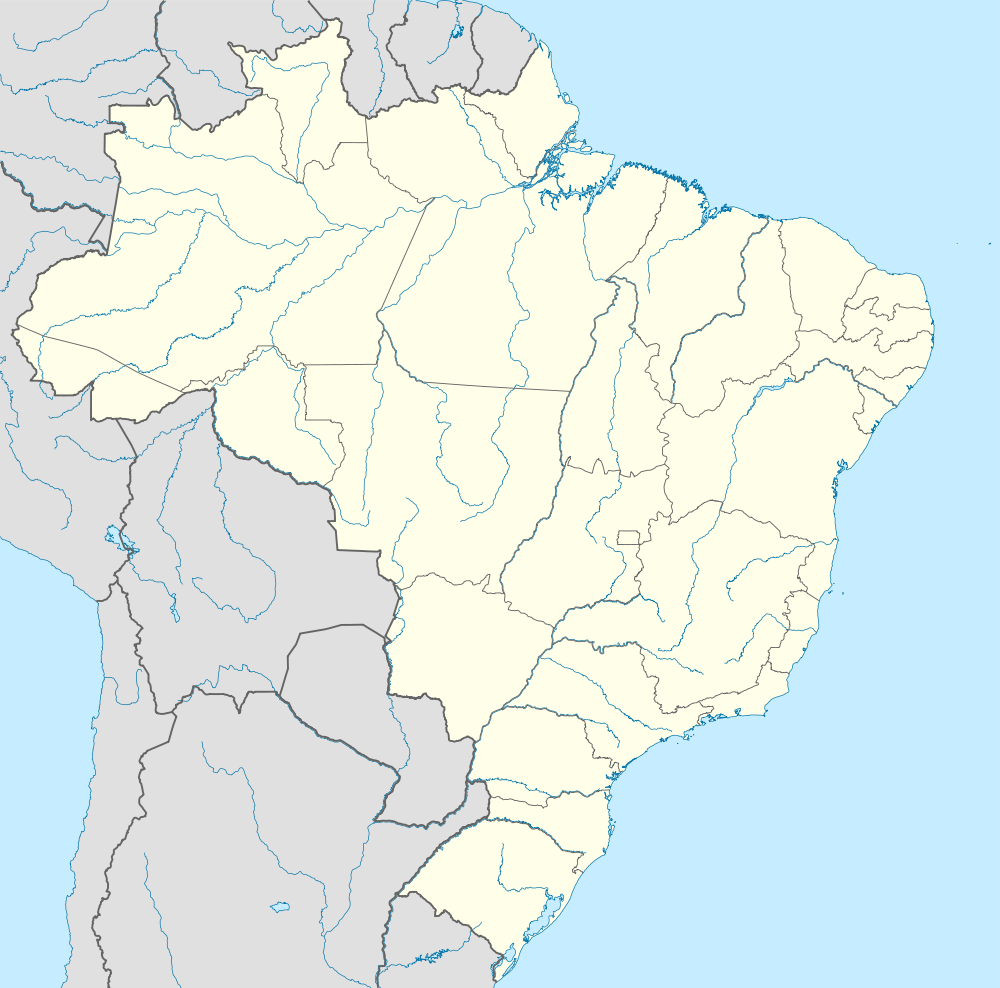Pilar do Sul
| Pilar do Sul | |
|---|---|
| Municipality | |
| The Municipality of Pilar do Sul | |
| Nickname(s): Nascente das Águas (Spring of Waters) and Pilar | |
 | |
 Pilar do Sul Location in Brazil | |
| Coordinates: 23°48′46″S 47°42′57″W / 23.81278°S 47.71583°WCoordinates: 23°48′46″S 47°42′57″W / 23.81278°S 47.71583°W | |
| Country |
|
| Region | Macro Metropolitana Paulista |
| State |
|
| Founded | 1936 |
| Government | |
| • Prefect | Antonio José Pereira (Democrats) |
| Area | |
| • Total | 682.395 km2 (263.474 sq mi) |
| Elevation | 689 m (2,260 ft) |
| Population (2010) | |
| • Total | 26,411 |
| Censo IBGE/2010[1] | |
| Demonym | Pilarense |
| Time zone | UTC-3 (UTC-3) |
| • Summer (DST) | UTC-2 (UTC-2) |
| Postal Code (CEP) | 18185-000 |
| Website | City of Pilar do Sul |
Pilar do Sul is a municipality in the state of São Paulo in Brazil. The elevation is 689 m. The population in 2010 is 26,411.[1] The area is 682,395 km².
History
The history of Pilar do Sul city began in 1850, when drovers, hunters and miners passed through the region to search precious metals. The place name may derive from the fact that many families from the state of Minas Gerais came to the locality to acquire stones that they used to make pestles to tenderize meat. In Portuguese the word "Pilar" means “to pestle.” The local stone was also used for tanning leather of hunted animals. Another possible source of the city’s name may stem from the religiosity of those Minas Gerais’ families, who had great devotion to Our Lady of Pilar, a Spanish Saint.
In 1865, Lieutenant Almeida acquired an allotment in the region and brought slaves to build a farm, and after that he built a small chapel in honor of Bom Jesus do Bomfim, to which he was devoted. In 1868, the lieutenant gave the land to the Diocese of Sorocaba. In 1877, João Batista Ribeiro, with permission of the bishop at the time, founded the town of Pilar, raising the town to the category of parish by a providential law. On May 12, 1891, through a decree, the town became a municipality, and on 20th of the same month stewardship of the town was established, with Eusebio de Moraes Cunha named as the first mayor of Pilar.
The city was slow to develop during the twentieth century. The poor roads and the sluggish growth of agriculture caused stagnation and the loss of political autonomy, with the town becoming a district of Piedade city in 1934. On November 5, 1936, Pilar regained its autonomy as a town. In March of the following year, Eugenio Theodoro Sobrinho took office as first elected mayor. In the same year, the House of Councilors passed a law that gave away lands within the town to all who wanted to build buildings of any kind. In 1944, the city officially changed its name to “Pilar do Sul."
Recently, Pilar do Sul has grown every year, giving greater emphasis to agricultural development, which is responsible for 70% of the municipal economy. Tourism, largely attributable to the beauty of local natural springs known as the "Spring of Waters," has also begun to develop, providing a boost to the city’s economy.
Notable People
Silvano Alves, Three-time Professional Bull Riders World Champion.
References
- ↑ 1.0 1.1 "Censo Populacional 2010". Censo Populacional 2010. Instituto Brasileiro de Geografia e Estatística (IBGE). 29 November 2010. Retrieved 11 December 2010. Archived 26 March 2011 at WebCite